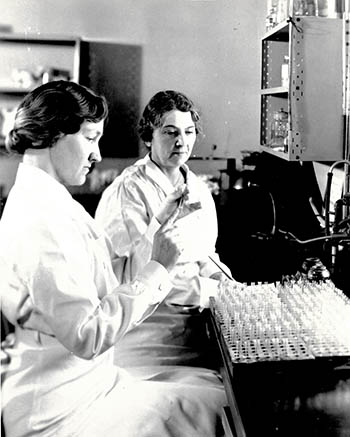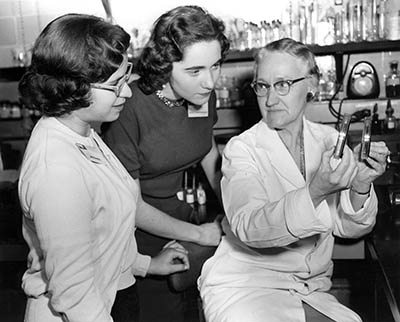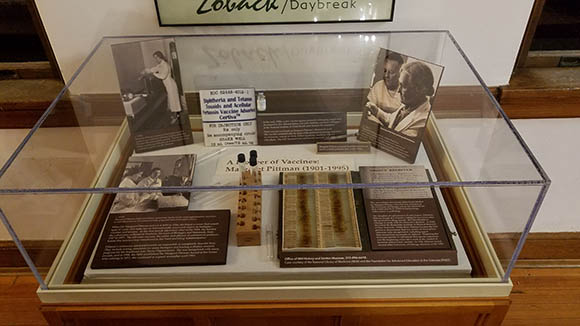From the Annals of NIH History
A Pioneer in Vaccines
Name this NIH luminary: She was an internationally recognized bacteriologist who worked at the NIH from 1936 until she retired in 1971. She was the first woman to head a laboratory at the NIH, becoming the chief of the Laboratory of Bacterial Products in 1958. And she stayed on as a guest worker for another 20 years after retiring, dying in 1995 at the age of 94.
Do you know whom we’re describing? Margaret Jane Pittman. Had she still been alive this past year, she would have decried the outbreak of measles in the United States and the severe outbreak (resulting in the death of at least 70, mostly children, by December 2019) in Samoa—all because of widespread misinformation about vaccinations. “Miss Information” is what she called herself in her oral history with the Office of NIH History and Stetten Museum, because other vaccine and infectious-disease researchers routinely sought her scientific advice.

CREDIT: NATIONAL MUSEUM OF AMERICAN HISTORY
Margaret Pittman and fellow NIH physician Sadie L. Carlin are “reading” an agglutination reaction, part of the test for potency of commercially prepared anti-meningitis serum during the meningitis epidemic of 1935-1937 (1937).
Pittman led the field in setting standards for the potency, stability, and sterility of vaccines, all of which assured the appropriate dosing and the safety of the products (the NIH licensed and tested commercial vaccines and sera until the early 1970s, when the Food and Drug Administration took over that responsibility). Her standards are still applied in modern-day vaccine production and have helped millions of people. For example, in the first 10 years after development of the pertussis vaccine, the death rate of children in the United States from this disease dropped from 9,000 per year to less than 20, according to the Centers for Disease Control and Prevention.
Pittman’s father, a general practitioner in Prairie Grove, Arkansas, sparked her interest in medicine by involving her in his practice. She was a brilliant student, graduating magna cum laude in 1923 from Hendrix College in Conway, Arkansas, with a double major in mathematics and biology. After teaching those subjects at Galloway College (Atlanta), she attended the University of Chicago, earning an M.S. in 1926 and a Ph.D. in 1929, both in bacteriology.
In 1928, she began working at the Rockefeller Institute of Medical Research (New York) with physician Rufus Cole, the first director of Rockefeller University Hospital, on whether Hemophilus influenza caused influenza. This question was one of the perplexing medical problems of that time. She discovered that there was more than one strain of this organism and that this bacterium was encapsulated, and it produced a toxin responsible for its severe clinical symptoms, at times leading to blindness and death in younger children. Developing a vaccine against the meningitis caused by this strain of H. influenza earned Pittman an international scientific reputation before she was 30 years old.
During World War II, Pittman investigated the safety of blood and blood products, especially those used on the battlefield. She discovered and eliminated the cause of fever and death attributed to plasma infusions and determined how to keep stored blood from becoming contaminated.

CREDIT: OFFICE OF NIH HISTORY
Margaret Pittman explains a test for the efficacy of a vaccine to visitors (c. 1960s).
Pittman served as president of the Society of American Bacteriologists (1928) and of the Washington Academy of Sciences (1955). She received many honors for her foundational contributions to public health, including the 1970 Federal Women’s Award. The Margaret Pittman Lectureship was created in 1994 by NIH to honor her exceptional research achievements.
Why are we testing your knowledge of Margaret Pittman? We have a new display case on the first floor of Building 60 (aka the Cloister or the Lasker Center) about her. You can see the pathology slides Pittman hand labeled for her Ph.D. classes nearly 100 years ago, as well as other items and photos from her long and impressive career as a vaccine pioneer. The display will be in Building 60 indefinitely before moving to another campus location.
The Office of NIH History and Stetten Museum at NIH advances the historical understanding of the biomedical research conducted at NIH by documenting, preserving, and interpreting records and artifacts. The office creates exhibits and other products, and helps scholars and researchers to navigate the rich history of NIH. For more information, go to https://history.nih.gov.
Don’t Miss the Pittman Lecture
The Wednesday Afternoon Lecture Series has an annual lecture in honor of Margaret Pittman. It is given by a researcher dedicated to advancing and improving the careers of women scientists. Since 1994 when this annual lecture began, every speaker has exemplified the intelligence, scientific excellence, and drive that made Pittman a leader as the first female laboratory chief at NIH. The next Pittman Lecture is scheduled for Wednesday, May 27, 2020, 3:00 p.m. to 4:00 p.m., in Masur Auditorium (Building 10) and will be given by Eve J. Higginbotham, S.M., M.D., Perelman School of Medicine, University of Pennsylvania. (Note: There’s a possibility that the lecture could be rescheduled.)

CREDIT: MICHELE LYONS, OFFICE OF NIH HISTORY
A display case on the first floor of Building 60 (aka the Cloister or Lasker Center) features Margaret Pittman and her laboratory research. The display will be in Building 60 indefinitely before moving to another campus location.
This page was last updated on Tuesday, March 29, 2022
